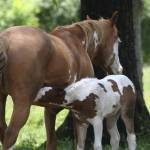Hormone Treatment to Advance Breeding Season in Horses

Mares are seasonally anestrous, meaning that they are not sexually receptive at all times throughout the year. They gradually transition from reproductive inactivity during the winter to breeding condition during the late winter and early spring months. As the hours of sunlight increase, longer days suppress melatonin, the hormone that prevents a mare from cycling throughout the winter months. Lowered melatonin levels allow the secretion of reproductive hormones that are necessary to induce ovulation and reproductive cycles.
Under natural conditions, mares are ready for breeding by late April, and those that are bred at this time will deliver their foals in late March of the following year. However, because the official birthday of all Thoroughbred horses is January 1 of the year following their birth, it is an advantage to have foals born earlier in the spring. Keeping mares under artificial light for several months in winter and early spring has been the management technique used to bring mares into season earlier, but this method is time-consuming and labor-intensive because mares must be brought into a lighted barn for part of the evening instead of maintained in pastures. Alternate treatments, such as a light mask that the mares can wear while they remain in the pasture, have been developed to enhance the process of producing earlier cycling in mares.
Researchers from the Gluck Equine Research Center at the University of Kentucky in collaboration with the University of California and Colorado State University have studied the use of hormones to advance the breeding season in mares. The purpose of the study was to determine the efficacy of an equine recombinant follicle stimulating hormone (reFSH) in noncycling mares housed under natural light conditions.
The study used 60 anestrous mares in California, Colorado, and Kentucky from the end of January until one or more pre-ovulatory follicles developed. The mares were divided into two groups and each mare received either a placebo or 0.65 mg of reFSH. The scientists monitored the mares closely by ultrasound until a 35 mm or larger follicle developed. They then discontinued reFSH treatment and administered human chorionic gonadotropin (hCG) to induce ovulation. Results showed that mares treated with reFSH all developed follicles after a week, and 23 of the 30 mares in this group ovulated within 72 hours after receiving hCG. None of the mares in the control group developed follicles during the study period.
Though treated mares developed follicles and ovulated, they returned afterward to an anestrous state rather than continuing to cycle through the remaining winter and early spring months. The researchers suggested that continuous treatment might be necessary in mares that failed to become pregnant following breeding on the induced ovulation.








